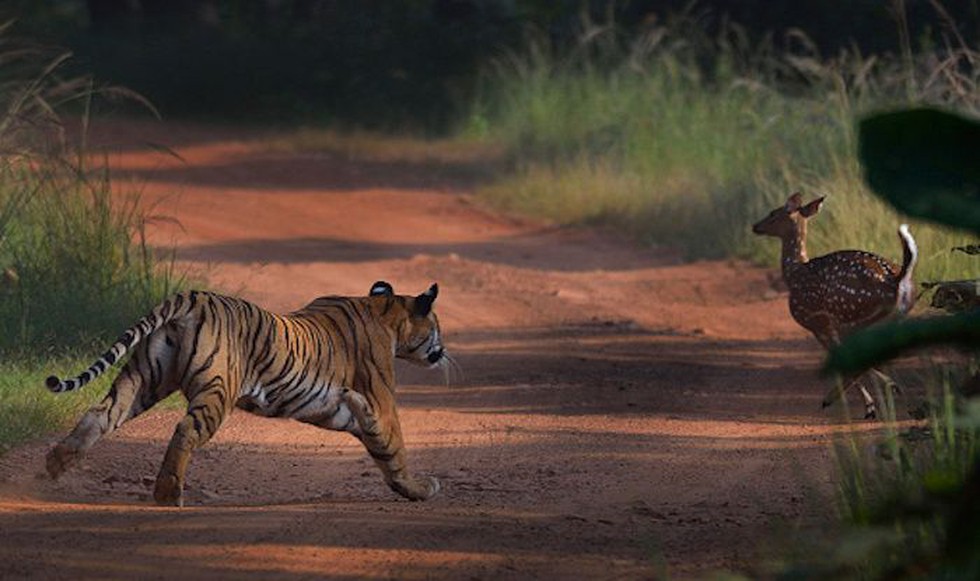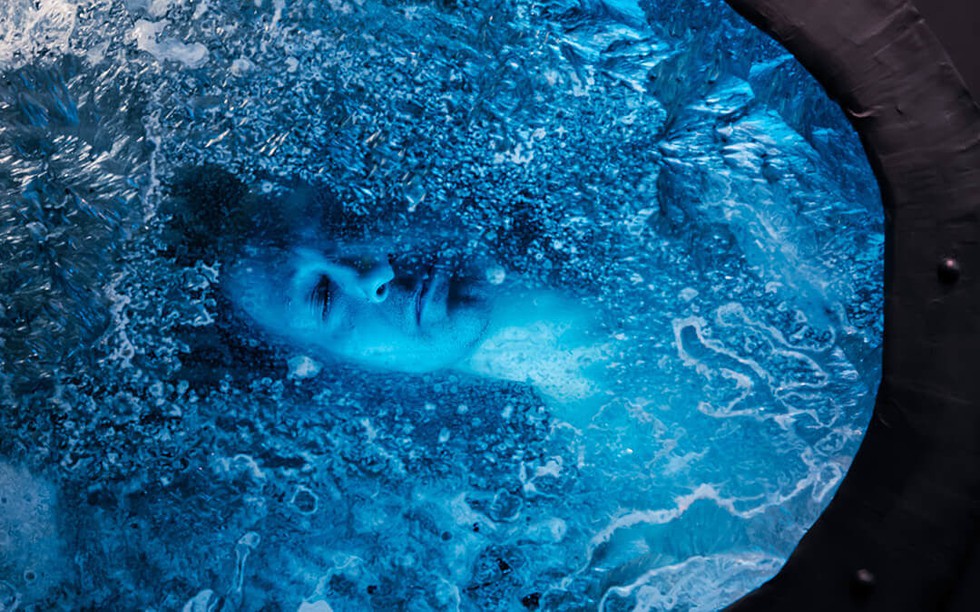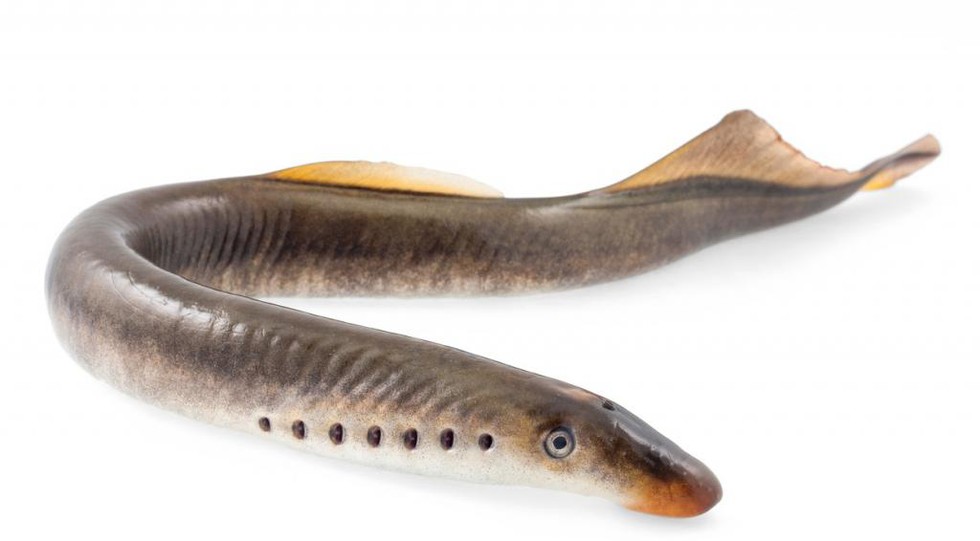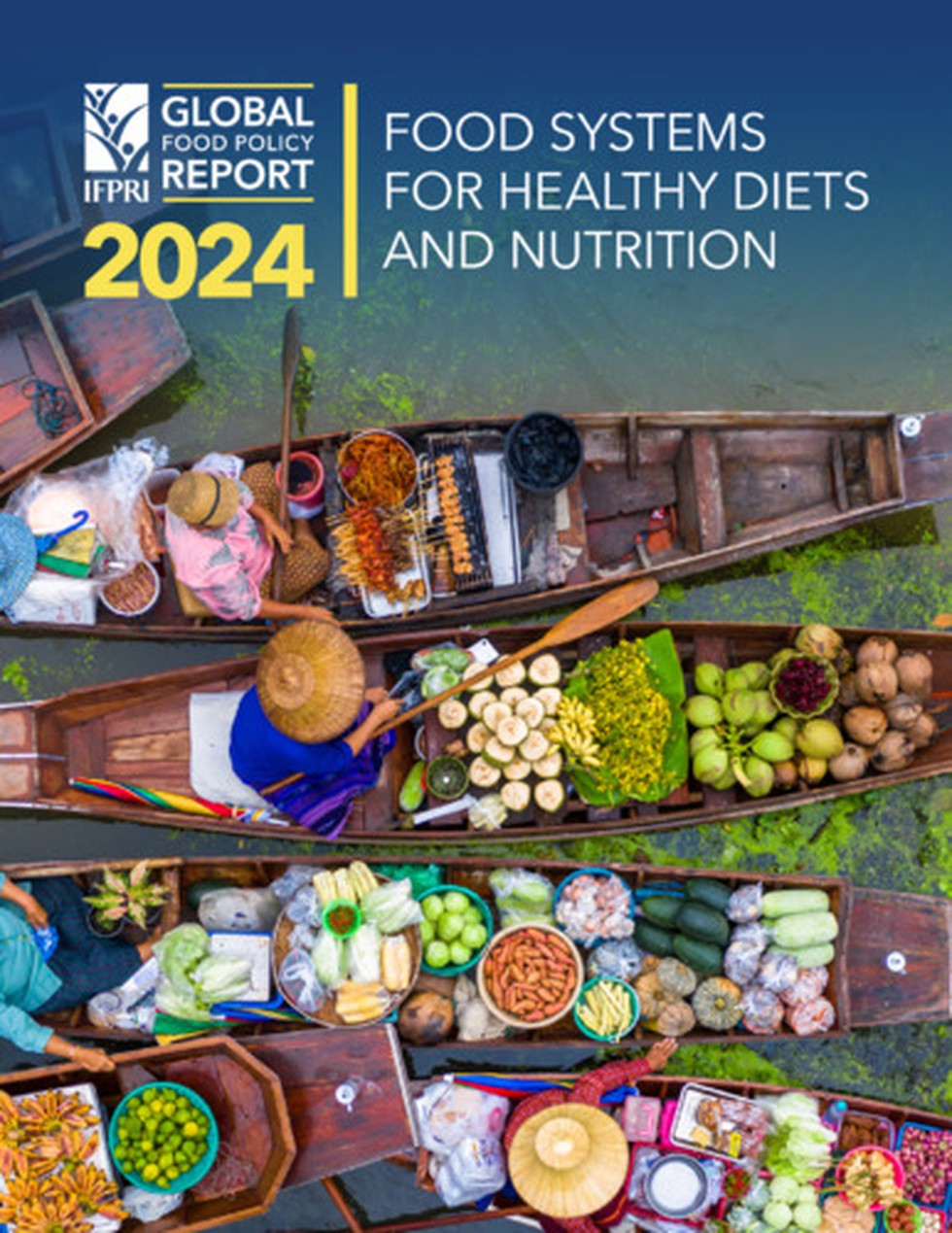1.Tadoba-Andhari Tiger Reserve
A 32-year-old woman was killed by a tiger in the buffer zone of the Tadoba Andhari Tiger Reserve (TATR) in Maharashtra's Chandrapur district recently. About Tadoba-Andhari Tiger Reserve:
About Tadoba-Andhari Tiger Reserve:
 About Tadoba-Andhari Tiger Reserve:
About Tadoba-Andhari Tiger Reserve:- Location: It is located in the Chandrapur district of Maharashtra.
- It includes Tadoba National Park and Andhari Wildlife Sanctuary.
- It is the largest and oldest Tiger Reserve in Maharashtra.
- The total area of the reserve is 625.4 sq. km.
- The origin of the name "Tadoba" lies with the name of the god "Tadoba" or "Taru", worshipped by the tribes that live in the dense forests of the Tadoba and Andhari regions. "Andhari" refers to the Andhari River that meanders through the forest.
- Corridor: The reserve has corridor linkages with Nagzira-Navegaon and Pench Tiger Reserves within the State.
- Biogeographically, the reserve falls in the Central Plateau province of the Deccan Peninsula.
- Vegetation: Southern Tropical Dry Deciduous
- There are two lakes and one waterway in the reserve, Tadoba Lake, Kolsa Lake, and the Tadoba River.
- Flora: Bamboo, Teak, Ain, Bija, Dhauda, Haldu, Salai, Semal, and Tendu. Bamboo and Teak dominatethe reserve.
- Fauna:
- The notable faunal species include the tiger, leopard, sloth bear, wild dog, gaur, chital, and sambar.
- As many as 280 species of birds are found, apart from reptiles (54 species), amphibians (11 species), and fishes (84 species).
2. External Commercial Borrowings (ECBs)
Registrations by Indian companies for External Commercial Borrowings (ECBs) almost doubled to $49.2 billion in the financial year 2023-24 (FY24) from $26.6 billion in FY23, according to data from the RBI.
 About External Commercial Borrowings (ECBs):
About External Commercial Borrowings (ECBs):
- ECBs refer to the borrowing of funds by Indian companies from foreign sourcesin the form of loans, bonds, or other financial instruments.
- Purpose: It can be used to finance a variety of purposes, including the expansion of business, the acquisition of assets, and the repayment of existing debt.
- Source of ECBs: ECBs can be obtained from a variety of sources, including foreign banks, international financial institutions, and foreign subsidiaries of Indian companies.
- ECB can be in the form of rupee-denominated loans, which are repaid in Indian rupees, or foreign currency-denominated loans, which are repaid in a foreign currency.
- Regulation: ECB is subject to regulatory oversight by the RBI, which sets limits on the amount of ECB that Indian companies can obtain and the purposes for which it can be used.
- The ECBs fall under the umbrella of RBI regulations as postulated under the Master Direction - External Commercial Borrowings, Trade Credits, and Structured Obligations (Master Direction), and the Foreign Exchange Management Act, 1999 (FEMA).
- ECBs should adhere to criteria like minimum maturity period, maximum all-in-cost ceiling, permitted and non-permitted end-uses, etc.
- As of today, there are two paths to raise funds by employing ECBs: the approval route and the automatic route.
- There are a variety of eligibility regulations created by the government for availing of finance under the automatic route.
- These regulations are about amounts, industry, the end-use of the funds, Companies that desire to raise finance via ECB must meet these eligibility criteria; thereafter, funds can be raised without needing approval.
- The approval route, on the other hand, mandates that companies which fall under certain pre-specified sectors must obtain the RBI's or the government's explicit permission, prior to raising funds through ECB.
- As per RBI guidelines, all entities except a Limited Liability Partnership are allowed to raise ECBs.
- Benefits:
- ECBs provide an opportunity to borrow large volumes of funds.
- The funds are available for a relatively long term.
- Interest rates are also lowercompared to domestic funds.
- ECBs are in the form of foreign currencies. Hence, they enable the corporate to have foreign currency to meet the import of machineries etc.
- Risks:
- Exchange rate risk:Fluctuations in the value of the Indian rupee against foreign currencies can affect the cost of repaying the loan.
- Sovereign risk: The ability of a foreign government to repay its debt can affect the creditworthiness of foreign lenders.
- Credit risk:Foreign lenders may not have the same level of protection as domestic lenders in the event of default.
- Regulatory risk: Changes to government regulations or policies related to the ECB can affect the availability and cost of borrowing.
3. Cryonics
A cryonics company has frozen its first client in Australia in the hope of bringing him back to life in the future. About Cryonics:
About Cryonics:
 About Cryonics:
About Cryonics:- Cryonics, the practice of freezing an individual who has died, with the object of reviving the individual sometime in the future.
- The word cryonics is derived from the Greek krýos, meaning “icy cold.”
- It is an effort to save lives by using temperatures so cold that a person beyond help by today’s medicine can be preserved for decades or centuries until a future medical technology can restore that person to full health.
- A person that is held in such a state is called a “cryopreserved patient”, because Cryonicists (the advocates of cryonics) do not regard the cryopreserved person as really dead.
- Cryonic preservation can be performed only after an individual has been declared legally dead.
- The process is initiated shortly after death, with the body being packed in iceand shipped to a cryonics facility.
- There, the blood is drained from the body and replaced with antifreeze and organ-preserving compounds known as cryoprotective agents.
- In this vitrified state, the body is placed in a chamber filled with liquid nitrogen, where it will theoretically stay preserved at -196 °C until scientists are able to find a way to resuscitate the body in the future.
- Currently, there are a few hundred bodies that have been frozen through cryonics.
Source: Australian Cryonics Firm Freezes First Client In Hopes Of Bringing Him Back To Life In Future
4. Red Flag 24 Exercise
An Indian Air Force (IAF) contingent recently arrived at the Eielson Air Force Base in Alaska to participate in the prestigious multi-national exercise, Red Flag 24.

About Red Flag 24:
- It is a two-week advanced aerial combat training exercise aimed at integrating aircrew in a multinational environment.
- It is designed to replicate a realistic and challenging environment, bringing together aircrew and equipment from different nations and services.
- Approximately 3100 service members are expected to fly, maintain, and support more than 100 aircraft during the exercise.
- The IAF deployed Rafale fighter jets for the Red Flag 24 exercise.
- The exercises can be adapted to integrate various forces into a realistic threat environment using the more than 77,000 square miles of airspace in the Joint Pacific Alaska Range Complex, which is the largest combat training range in the world.
- Since its inception in 1975, Red Flag exercises are designed to create a comprehensive learning environment by simulating realistic combat scenarios.
- There are two distinct Red Flag exercise locations: Nellis Air Force Base in Nevada and Eielson Air Force Base in Alaska.
- The Nevada exercise is organized by the United States Air Force Warfare Center (USAFWC), while the Alaska exercise is managed by the Pacific Air Forces (PACAF), the air component command of the United States’ Indo-Pacific Command (USINDOPACOM).
5. Framework for Recognising Self-Regulatory Organisation for the FinTech Sector (SRO-FT)
The Reserve Bank of India (RBI) recently issued the Framework for Recognising Self-Regulatory Organisation for the FinTech Sector (SRO-FT) for better self-governance and compliance by firms in this space.

About SRO-FT Framework:
- The framework defines fintech as entities providing technological solutions for delivery of financial products and services to businesses and consumers or encompassing regulatory and supervisory compliance in partnership with traditional financial institutions or otherwise.
- The SRO-FT would be industry-led and will be responsible for establishing and enforcing regulatory standards, promoting ethical conduct, ensuring market integrity, resolving disputes and fostering transparency and accountability among its members.
- The applicant should be set up as a not-for-profit company, and its shareholding should be sufficiently diversified, with no entity holding 10% or more of its paid-up share capital, either singly or acting in concert.
- Applicants will need to have a minimum net worth of ₹2 crore within one year after recognition as an SRO-FT or before commencement of operations, whichever is earlier.
- At least one-third of members on the board, including the chairperson, should be independent and without any active association with a fintech entity.
- Further, the majority of non-independent directors are to be representatives of FinTechs that are currently not directly regulated.
- Applicants should demonstrate the capability of establishing the necessary infrastructure to act as an SRO-FT effectively and consistently.
- It will also need to put in place systems for managing ‘user harm’ instances, which may include fraud, mis-selling, unfair practices, unauthorised transactions, or any other form of misconduct.
- While the SRO can’t open branches or offices outside India, FinTechs domiciled outside India can become members of an SRO.
- The number of SRO-FTs to be recognised would depend on the number and nature of the applicants received, and the RBI reserves the right not to grant recognition to any such application.
- If deemed necessary, Reserve Bank of India (RBI) can nominate or depute observers on the SRO-FT's board.
- Responsibilities:
- An SRO-FT should operate objectively under the oversight of RBI, and strive towards healthy and sustainable development of the sector.
- A fintech SRO should frame a code of conduct for members, set industry benchmarks and baseline technology standards for transparency, disclosure and data privacy, set standardised documents for specific requirements, set up a mechanism for accreditation in the fintech ecosystem, and a code of conduct for responsible advertisements and market standards.
- The SRO-FT should have adequate powers to investigate and take disciplinary action against its members for non-adherence to codes/standards/rules.
- Responsibilities towards RBI would include relaying sector-specific insights, addressing regulatory concerns, collaborate on the development of the sector, fostering co-operation, providing policy commensurate to the dynamic nature of the sector, acting as the collective voice of its members, providing regular updates on sector developments and collect and share relevant data.
6. LignoSat
In a world-first, Japanese researchers have built a tiny wooden satellite named LignoSat that will be launched into space in September.

About LignoSat:
- LignoSat”, a fusion of “ligno” (the Latin word for wood) and “satellite”,.
- It is developed by collaborative research and development by a team comprising members from Kyoto University and Sumitomo Forestry Co.
- Objective: Their objective is to leverage the eco-friendliness and cost-effectiveness of wood in space exploration.
- It is constructed from magnolia wood, chosen for its durability and adaptability.
- Why wood is used?
- Wooden satellites are viewed as more environmentally friendly upon reentering the Earth's atmosphere at the conclusion of their mission. Unlike metal satellites, which pose air pollution risks due to the generation of metal particles during reentry, wooden satellites mitigate these concerns.
- It will first be sent to the International Space Station (ISS) aboard a SpaceX rocket from the Kennedy Space Center.
- Once it reaches the ISS, it will be released from the Japanese experiment module to test its durability and strength.
- Researchers will receive data from the satellite to monitor its performance, including signs of strain and its ability to withstand extreme temperature changes.
7. Recombinant Proteins
Researchers at the Department of Biochemistry, Indian Institute of Science, have developed a novel method for the production of recombinant proteins.

About Recombinant Proteins:
- These are proteins encoded by recombinant DNA that have been cloned in an expression vector that supports the expression of the gene and translation of messenger RNA.
- Modification of the gene by recombinant DNA technology can lead to the expression of a mutant protein.
- It is a manipulated form of native protein, which is generated in various ways in order to increase the production of proteins, modify gene sequences and manufacture useful commercial products.
- It is created by fusing sequences that may not be normally present in an organism.
- Recombinant proteins, such as vaccine antigens, insulin and monoclonal antibodies, are mass-produced by growing modified bacterial, viral or mammalian cells in large bioreactors. The most widely used organism is the yeast Pichia pastoris (now called Komagataella phaffii).
- Application of Recombinant Proteins
- It is used in biomedical research to understand health and disease.
- It is used in Biotherapeutics.
- It is used to produce protein-based polymers for drug delivery, antibodies and enzymes for disease treatment, protein scaffolds for tissue engineering etc.
What is protein?
- It is the workhorse in biological systems facilitating most of biological processes in a cell, including gene expression, cell growth, proliferation, nutrient uptake, intercellular communication and apoptosis.
- The blue print for protein synthesis is stored in DNA, which serves as a template for highly regulated transcriptional processes to produce messenger RNA (mRNA).
8. Diadromous fish
The study, published in the British Ecological Society’s Journal of Applied Ecology, found that MPAs designated to protect diadromous fish species did not align with their core habitats.
 About Diadromous fish:
About Diadromous fish:
- These are those fish species which migrate between saltwater and freshwater environments.
- Examples of diadromous fish: the allis shad (Alosa alosa), twait shad (Alosa fal- lax), Mediterranean twaite shad (Alosa agone) and the European eel (Anguilla anguilla) etc.
- In order to better understand these movements, scientists have classified these migrations into several categories.
- Anadromous fish: These are born in freshwater, then migrate to the ocean as juveniles where they grow into adults before migrating back into freshwater to spawn.
- Catadromous fish: These are born in saltwater, then migrate into freshwater as juveniles where they grow into adults before migrating back into the ocean to spawn.
- Amphidromous fish: These are born in freshwater/estuaries, then drift into the ocean as larvae before migrating back into freshwater to grow into adults and spawn.
- Potamodromous fish: These are born in upstream freshwater habitats, then migrate downstream (still in freshwater) as juveniles to grow into adults before migrating back upstream to spawn.
- Threats: Diadromous fish are sensitive to anthropogenic pressures. They are subjected to terrestrial, freshwater, and marine pressures such as agricultural and pollutant runoffs, habitat destruction, barriers to migration, fishing, bycatch and climate change.
9. KAZA Summit
More than 400 delegates are gathered in Livingstone, a Zambian resort town on the northern side of Victoria Falls, for the inaugural Kavango-Zambezi (KAZA) Trans-Frontier Conservation Area (TFCA) summit.

About KAZA Summit:
- Objectives
- To assess the progress made in establishing and developing the KAZA-TFCA since its inception.
- To review and track the progress of the Memorandum of Understanding done in 2016 and the implementation of the KAZA Treaty done in 2011.
- Seeks to get renewed commitment from the current leaders of the member countries.
- Theme of the summit: “Leveraging KAZA’s natural capital and cultural heritage resources as catalysts for inclusive socio-economic development of the eco-region.”
Key facts about KAZA Region
- The Kavango-Zambezi Trans-Frontier Conservation Area (KAZA-TFCA) is a 520,000-square kilometre wildlife sanctuary straddling five southern African nations that share common borders along the Okavango and Zambezi river basins.
- These nations — Angola, Botswana, Namibia, Zambia and Zimbabwe— together with South Africa, are home to more than two-thirds of the African elephant population.
- It is home to a high concentration of wildlife species, including the largest elephant population.
- About 70 per cent of KAZA land is under conversation made up of 103 wildlife management areas and 85 forest reserves.
- Within it are also three World Heritage sites namely the Victoria Fallson the Zambezi river which makes the border between Zambia and Zimbabwe and the Okavango Delta and the Tsodilo Hills both in Botswana.
- The KAZA states signed a Memorandum of Understanding in 2006 resulting in the KAZA Treaty of 2011 followed by its immediate implementation.
- The KAZA-FTCA area is a partnership centred around “a common vision to conserve biodiversity at scale through promoting integrated transboundary management and to market the landscape biodiversity using nature-based tourism as the engine for rural economic growth and development.”
10. Global food policy report 2024
Recently, Global food policy report 2024: Food systems for healthy diets and nutrition was released by International Food Policy Research Institute (IFPRI)

Key highlights of Global food policy report 2024:
- It mentions that at least 38 per cent of the Indian population ate unhealthy foods, while only 28 per cent ate all five recommended food groups, which include at least one starchy staple food, one vegetable, one fruit, one pulse, nut or seed and one animal-source food.
- The consumption of such calorie-dense and nutrient-poor foods was not only high but was also increasing, while the consumption of vegetables and other micronutrient-rich foods was low.
- In India and other South Asian countries, consumption of processed foods is on the rise. After cereals and milk, snacks and prepared foods accounted for the majority of Indian food budgets.
- In India, the proportion of the population suffering from malnutrition increased from 15.4% in 2011 to 16.6% by 2021.
- The prevalence of overweight in adults increased from 12.9% in 2006 to 16.4% in 2016.
- Similarly, the share of packaged (highly processed and calorie-dense) foods in household food budgets nearly doubled during this period, to 12 per cent from 6.5 per cent.
- In the South Asian region, the report highlighted that micronutrient-rich foods were expensive, whereas cereals, fats and oils, sugar, and sugary and salty snacks were relatively inexpensive.
Key facts about the International Food Policy Research Institute (IFPRI)
- It was established in 1975 and provides research-based policy solutions to sustainably reduce poverty and end hunger and malnutrition in developing countries.
- It is a research centre of CGIAR, which is the world’s largest agricultural innovation network.
- Its research focuses on five strategic research areas:
- Fostering Climate-Resilient and Sustainable Food Supply
- Promoting Healthy Diets and Nutrition for Al
- Building Inclusive and Efficient Markets, Trade Systems and Food Industry
- Transforming Agricultural and Rural Economies
- Strengthening Institutions and Governance
- Headquarters:Washington, D.C


























































































































































.png)
.png)
.png)
.png)
.png)


.png)
.png)
.png)





.png)
.png)






.png)
.png)
.png)
.png)
.png)
.png)
.png)
.png)
.png)

.png)







.png)
.png)


.png)
.png)
.png)


.png)

.png)
.png)





.jpg)

.png)
.png)


.png)

.png)
.png)
.png)

.jpg)

.jpg)


.png)

.png)
.png)
.png)
.png)
.png)
.png)
.png)
.png)
.png)
.png)




.png)

.png)





.png)
.png)
.png)
.png)
.png)
.png)
.png)
.png)
.png)
.png)
.jpg)
.jpg)

.png)
.png)
.png)
.png)
.png)
.png)
.png)
.png)
.png)
.png)
.png)
.png)
.png)
.png)
.png)
.png)
.png)
.png)
.png)
.png)
.png)
.png)



.png)
.png)

.jpg)
.jpg)


.jpg)
.jpg)
.jpg)
.jpg)
.jpg)

.jpg)








.jpg)
.jpg)
.jpg)
.jpg)
.jpg)

















.jpg)
.jpg)







.jpg)


















.jpg)
.jpg)






























































































.jpg)
.jpg)


























.jpg)

.jpg)










.jpg)








.jpg)




.jpg)










.jpg)


















.jpg)












































.jpg)














.jpg)
.jpg)
.jpg)





.jpg)

.jpg)
.jpg)





































































.jpg)


































.jpg)
.jpg)
















































.jpg)












.jpg)


.jpg)




.jpg)
.jpg)
.jpg)

.jpg)
.jpg)
.jpg)
.jpg)

.jpg)
.jpg)
.jpg)

.jpg)
.jpg)
.jpg)
.jpg)
.jpg)
.jpg)
.jpg)
.jpg)

.jpg)


.jpg)
.jpg)
.jpg)
.jpg)
.jpg)
.jpg)
.jpg)
.jpg)
.jpg)
.jpg)











.jpg)
.jpg)





.jpg)
.jpg)
.jpg)
























.jpg)
























.jpg)









.jpg)
.jpg)







.jpg)
.jpg)









































.jpg)
.jpg)
.jpg)
.jpg)
.jpg)

.jpg)
.jpg)
.jpg)
.jpg)
.jpg)


.jpg)
.jpg)
.jpg)
.jpg)
.jpg)

.jpg)
.jpg)
.jpg)
.jpg)
.jpg)
.jpg)
.jpg)
.jpg)
.jpg)
.jpg)
.png)

.png)
.png)

.png)
.png)
.png)
.png)


.jpg)
.jpg)

.jpg)
.jpg)
.jpg)

.png)
.png)
.png)
.png)
.png)
.png)
.png)

.png)
.png)
.png)
.png)
.png)
.png)
.png)
.png)
.png)
.png)





































































-min.png)



.png)




.png)








































